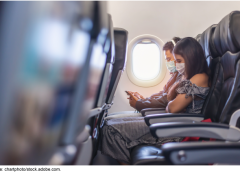
Contact Tracing for Air Travel: CDC’s Data System Needs Substantial Improvement
[ad_1]
What GAO Found
The Centers for Disease Control and Prevention (CDC) plays a key role in contact tracing for air travel—the process of identifying and notifying passengers who may have come into contact with a person infected with a communicable disease during a flight. However, several factors affect CDC’s ability to collect timely, accurate, and complete air passenger information to support contact tracing by local public health authorities. For example, airlines may not have accurate and complete information about passengers to share with CDC because the contact information provided to book a ticket may be for a third party, like a travel agent, not for passengers. Further, because no single, complete, and reliable source of passenger information exists, CDC often conducts research to fill in gaps, extending the time it takes to share information with local public health authorities.
Overview of Process for Collecting Air Passengers’ Contact Information

Since the start of the COVID-19 pandemic, CDC has taken some actions to improve the quality of information it collects. For example, since November 2021, CDC has required airlines to collect certain information—including name, phone number, email, and physical address—no more than 72 hours before departure from passengers traveling on flights into the United States and to transmit the information to CDC in a defined format.
However, limitations in how CDC collects and manages air passengers’ contact information—including CDC’s use of an outdated data management system—hinder the agency’s ability to monitor public health risks and facilitate contact tracing. The data management system—developed in the mid-2000s—was not designed for rapid assessment or aggregation of public health data across individual cases. For example, CDC is unable to quickly and accurately identify the number of passengers exposed to a specific infected passenger on a flight. Nor does the system contain the necessary data fields to assess the quality of air passenger information CDC receives, such as a field to determine the timeliness of airlines’ responses to CDC’s request. Consequently, CDC is not positioned to efficiently analyze and disseminate data to inform public health policies and respond to disease threats. Nor is it positioned to evaluate its performance in collecting and sharing quality passenger information.
Why GAO Did This Study
The COVID-19 pandemic has underscored the importance of public health measures aimed at controlling the transmission of communicable diseases. Air travel can play a role in quickly spreading communicable diseases across the world and throughout communities. Given this potential, contact tracing for air passengers is an important measure for protecting public health.
GAO was asked to examine CDC’s process for collecting and managing air passengers’ contact information to facilitate contact tracing. This report addresses: (1) the factors that affect CDC’s ability to collect this information, (2) recent actions CDC has taken to improve the quality of the information it collects, and (3) how effectively it collects and manages this information.
GAO reviewed relevant federal documentation, including regulations, orders, technical guidance, and public comments, as well as available CDC data. GAO also interviewed officials from CDC, U.S. Customs and Border Protection, and the Federal Aviation Administration, and selected representatives from the aviation, travel, and public health industries.
[ad_2]
Source link


